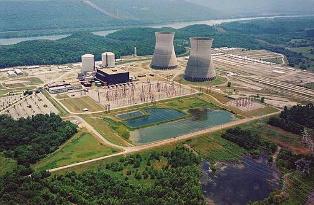Reactor completion the preferred choice
25 May 2010
Completion of a partially built reactor, rather than construction of a brand new one, has been identified as the Tennessee Valley Authority's (TVA) preferred alternative for its Bellefonte site in Alabama.
 |
| Bellefonte 1 and 2 - ready for completion? |
A newly published final supplemental environmental impact statement (final SEIS) on TVA's proposal to operate a single nuclear unit at the site evaluates two alternative construction options: the completion and operation of one of two partially constructed Babcock & Wilcox (B&W) pressurised water reactors (PWRs) at the site, or the construction and operation of a new Westinghouse AP1000.
TVA said its integrated assessment of the two alternatives has resulted in identifying the completion of unit 1 (one of the partially completed B&W units) as the preferred project. "The assessments conclude that from financial, schedule, and risk-minimisation perspectives, this is the preferred generation option," the FEIS notes. Transmission systems would also need to be upgraded to support this option.
Ashok Bhatnagar, senior vice president of nuclear generation development and construction at TVA, said that completing a nuclear unit would help the authority to meet its customers' growing needs while providing a reliable and safe power source at significantly less cost per installed kilowatt than other generation options. "At the same time, additional nuclear generation leads to a reduction of our carbon footprint," he added.
The FEIS is the fourth of five detailed studies being prepared to support a future decision by the TVA board about whether to operate a nuclear reactor at Bellefonte. The fifth study will evaluate the financing options to support construction. TVA directors are expected to make a decision on the proposed nuclear unit at a meeting scheduled for 20 August. The authority is also in the process of developing an Integrated Resource Plan to help identify regional electricity needs over the next two years.
Whether the option of a new reactor or the completion of one of the existing units is ultimately chosen, TVA has already determined that the transmission network will need to be upgraded to be able to cope with transmitting electricity generated at the site. The upgrades would consist of modifications to 222 miles (just over 355 kilometres) of existing transmission lines and two existing switchyards. No new transmission lines would be needed.
Work began on two PWRs at Bellefonte in the 1970s but construction was suspended in 1988 when power demand fell. At that point, unit 1 was 88% complete and unit 2 about 58% complete. The plant was maintained in deferred status until 2005 when TVA formally cancelled the units to allow the site to be considered for other uses. In 2007, it applied for a combined Construction and Operating Licence (COL) to build two AP1000s at the site.
In a unique regulatory move, the US Nuclear Regulatory Commission (NRC) has since reinstated the construction licences for the partially built plants, restoring the status of the cancelled reactors first to "terminated" and then, in January 2010, to "deferred" status. The reinstated construction licences for Bellefonte units 1 and 2 are due to expire in 2011 and 2014 respectively.
TVA has already completed four mothballed reactors (three units at Browns Ferry and Watts Bar unit 1) and is working on a project to bring a fifth (Watts Bar unit 2) into service by 2013.
Bellefonte was originally chosen by the NuStart consortium as the reference COL application for the AP1000, but the consortium subsequently decided to transfer the reference application to the Vogtle site in Georgia, where Southern Nuclear Operating Company has plans for two of the units.
Researched and written
by World Nuclear News